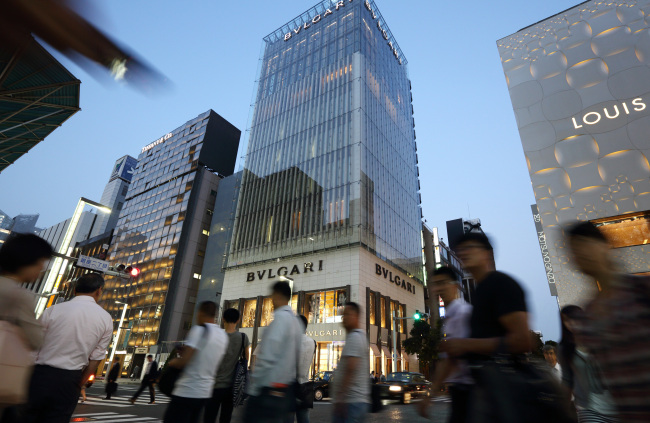TOKYO (AFP) ― Japan’s economy saw its strongest expansion in more than two years during the first quarter of 2013, revised data showed Monday, but a sales tax rise has weighed on growth since the levy hike.
The world’s number-three economy grew by 1.6 percent between January and March, slightly faster than an initial estimate of 1.5 percent, and 6.7 percent on an annualized basis ― a hypothetical figure that stretches the pace of growth over the course of a year.
The latest figures confirmed the economy staged the biggest expansion since a 2.6 percent growth in the July-September quarter of 2011, when it was rebounding from the earthquake-tsunami disaster in March of that year.
The nation’s cash registers rang up big sales in the first quarter ahead of the April 1 consumption tax rise from 5.0 percent to 8.0 percent ― seen as crucial to paying down Japan’s massive public debt.
 |
Pedestrians walk past a Tiffany & Co. store (left), Bulgari SpA store, a luxury unit of LVMH Moet Hennessy Louis Vuitton SA (center) and a Louis Vuitton store in the Ginza district of Tokyo. (Bloomberg) |
Millions of shoppers scooped up everything from cars and refrigerators to televisions and alcohol in a spending spree ahead of the expected price rises.
But consumers have since reined in their buying, with the economy stumbling in April as household spending dived.
Earlier figures showed that spending tumbled 13.3 percent in April, which followed a similar dip in retail sales, and came as separate figures showed industrial production slipping.
“Output will surely shrink this quarter as consumers rein in spending after the consumption tax hike,” Capital Economics said after the revised data were published.
“However, the slowdown in domestic demand should lead to a decline in import volumes, so net exports should finally add to growth. More importantly, business surveys started to recover last month, which suggests that any weakness should prove short-lived.”
Worries about the strength of Japan’s recovery have put a renewed focus on whether the Bank of Japan would unleash further easing measures to counter the downturn.
The focus on the BOJ’s easing was highlighted by the International Monetary Fund in its annual review of Japan last month, with the Washington-based organization saying that “the current aggressive pace of monetary easing may need to be maintained for an extended period.”
The “BOJ should act quickly if actual or expected inflation stagnates or growth disappoints,” it added.
The bank’s unprecedented easing program, unveiled last year, gave the economy a shot in the arm, but Governor Haruhiko Kuroda has repeatedly said he is ready to expand the stimulus if necessary.
So far the bank has held off such a move, saying it would assess the impact of the sales tax rise.
The loose monetary policy is part of a three-pronged drive by Prime Minister Shinzo Abe to defeat years of deflation and reinvigorate the economy.
Abe has also embarked on a huge spending drive, and plans a series of structural reforms.
But critics have derided the BOJ’s moves as a risky money-printing exercise, and there is increasing skepticism over its target to reach a steady 2.0 percent inflation rate by next year.
There are growing calls for Tokyo to launch deeper economic reforms ― including free-trade deals and more flexible labour markets ― to protect the recovery.
Abe has made some changes, including a bid to deregulate the energy sector.
But it was unclear if he would make good on a wider overhaul that was sure put him on a collision course with the agricultural sector and other politically powerful groups.
In other data Monday, Japan’s current account surplus in April narrowed by 76.1 percent from a year earlier to 187.4 billion yen ($1.8 billion).
Japan maintained a surplus in the current account, the broadest measure of its trade with the rest of the world, for the third consecutive month, but it was far smaller than market expectations of more than 300 billion yen.








